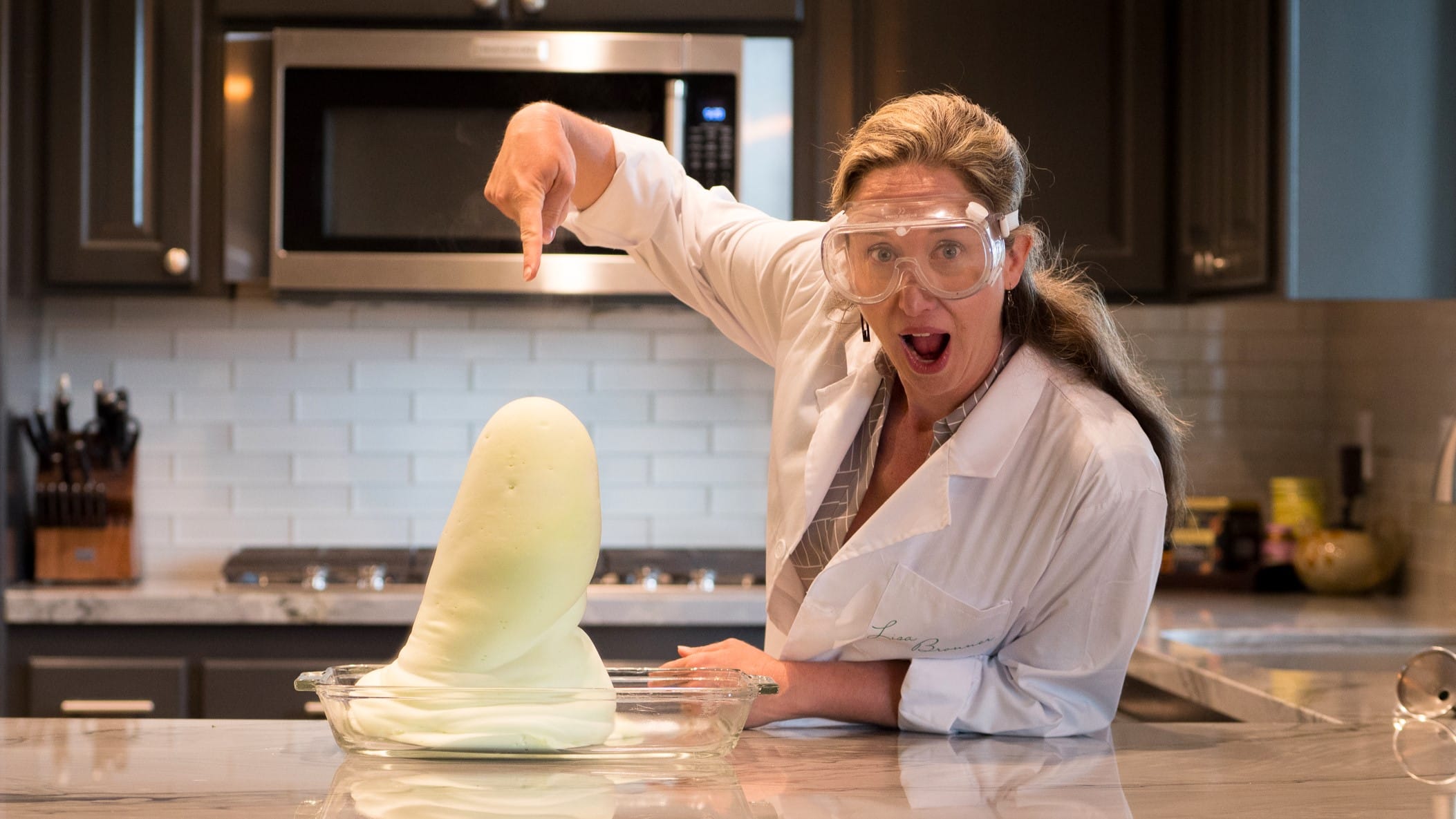
Chemistry is awesome. It gives us yummy food, beautiful art, life-saving medicines, and fireworks. I grew up in a household where chemistry was front and center. My dad Jim Bronner (younger son of Dr. Bronner) was a chemist and inventor, and since inspiration often struck outside his working day, our garage was his off-hours laboratory.
He invented Class-A firefighting foams and Snofoam, originally a special effects fake snow for Hollywood which became the centerpiece of Dr. Bronner’s Magic Foam Experience. And he invented Sal Suds, for which I—and parents, pet owners, and home dwellers everywhere—will be forever grateful. And he was a fantastic cook, which I don’t think is coincidental.
By and large, my dad knew what he was doing. There might have been the occasional absent-minded professor moment, but my mom usually caught situations before anything drastic happened. (Though she did outright forbid the at-home testing of the gelled alcohol formulation he was developing to assist firefighters with controlled burns. My two brothers, David and Mike, were a little too interested in that one.)
But what I want to talk about here is accidental chemistry. As in, the chemical reactions that can happen to a regular person (i.e. not a chemist) who is just trying to take care of their house. Usually this starts with the best of intentions, when someone combines two different substances, thinking to harness the potential of both to create something even better. Instead, they end up destroying both and creating something that does no good.
Accidental chemistry started my blogging
One of the reasons I started writing my Going Green blog was to comment on inadvertent chemical reactions people were experiencing as they tried to clean their homes. Back in the ‘00s, there was surging interest in DIY green cleaning, which I later re-termed “GIY cleaning,” as in “green-in-yourself.” Folks were becoming aware of the hazards rampant in store-bought cleaning products and so wanted to make their own household cleaners. This was an excellent desire to employ simpler, safer, and cheaper ingredients.
However, while there were many great recommendations out there, there were also a good number of misguided and downright terrible recipes, which if tried, would discourage anyone from continuing on their green cleaning journey. Some of these convoluted concoctions would send folks right back to the store to pick up the latest-and-greatest marketed off-the-shelf spray, with all the problems that come with it.
My desire to address these misguided mixtures wasn’t just out of the goodness of my heart. We had a stake in the effort because a lot of these recipes used Dr. Bronner’s Pure-Castile Magic Soap, and the bad recipes made the soap look bad. Case in point were the plethora of recipes that called for combining the Castile Soap with vinegar. It was my brother Mike (that would be Dr. Bronner’s President Mike Bronner) who first asked me to evaluate and publish my feedback on these recipes, so that people would understand that it wasn’t our soap that was causing the problems, but rather the combination of ingredients.
And so in 2010, I pivoted from my previous experience teaching writing and literature and started teaching about household chemistry. Something I still do to this day!
“Chemical” isn’t a bad word
You’ll hear me say “chemical” and “chemistry” a lot, and these are not nasty words. A chemical is any substance that is made up of elements, whether it’s a single element, like C for carbon (or diamonds!), or a group of elements like C₁₂H₂₂O₁₁, aka sugar, or CaCO3, which can be marble, limestone, or pearl depending on the atomic arrangement. Chemistry is funny that way. Water, soap, and what I’m about to eat for dinner are also all chemicals.
In fact, it’s far more interesting to think about what in our world is not a chemical. Non-chemicals include energy, light, magnetism, gravity, and love.
So when I get asked about “cleaning without chemicals” or “does your soap contain chemicals,” I pause and ponder what the questioner really wants to know. Usually, they want to know how to clean without harming themselves, their pets, and their environment. Excellent topics. Once I have this in mind, we can get started.
Cleaning chemicals not to mix
Certain common household chemicals should not be mixed together. Some create useless but harmless results, and some create deadly compounds. When I’ve brought this topic up elsewhere, I’ve been accused of providing instructions to nefarious people. However, I figure if someone has ill-intent, they can find this information readily. My goal here is to reach people who are really trying to do the right thing, who have the best of intentions, but might instead end up with a mess, or worse, on their hands.
In the table below, where you see “Soap,” I am referring to a true soap, that is the salt of a fatty acid that is produced by reacting an oil or fat with a strong alkali. Dr. Bronner’s Pure-Castile Magic Soap is an example of a true soap. The other type of surfactant is detergent. Detergents are a vast and varied group of cleaning compounds, with different features that I can’t address on the whole. Therefore, I specifically refer to Dr. Bronner’s Sal Suds Biodegradable Cleaner, which I know best.
| Combinations to Avoid | Produces | Problem |
|---|---|---|
| Soap & Vinegar | Oily gunk | Vinegar breaks the soap down to fatty acids; messy but not dangerous |
| Soap & Alcohol | Less effective cleaner | Alcohol interferes with soap’s ability to grab on to oil and grime |
| Soap & Epsom salts (Magnesium sulfate) | Soap scum | Produces film that clings to surfaces and can clog pipes |
| Baking Soda & Vinegar | Sodium acetate, carbon dioxide, and water | Of some use at the moment of reaction, but no use afterwards |
| Sal Suds & Vinegar | Less effective cleaner | Vinegar lessens cleaning power of Sal Suds |
| Soap & Oil | Creamy mixture of soap bonded to oils | The attraction between soap and oil inhibits the cleaning ability of soap or nourishing ability of oils |
| Soap & Hydrogen Peroxide | Outgassed oxygen, soap and water | Hydrogen peroxide quickly breaks down to oxygen and water, eliminating any benefit. Use separately |
| Soap & Bleach | Higher pH soap | More caustic soap that is irritating to the skin |
| Hydrogen Peroxide & Vinegar | Peracetic acid | Highly corrosive liquid |
| Bleach & Vinegar | Chlorine gas | Highly dangerous vapors |
| Bleach & Ammonia | Mustard gas | Highly dangerous vapors |
| Bleach & Rubbing Alcohol | Chloroform | Highly dangerous vapors |
Do not mix storebought cleaners
I’m going to say this the most straightforward way I can.
Do not mix storebought cleaners together, even if you have two cleaners that do the same thing.
For example, let’s say you have two store-bought toilet bowl cleaners. The active ingredients could be different and highly reactive. For example, one toilet bowl cleaner may use hydrochloric acid (not a common household ingredient, but not uncommon in store-bought formulations) as its active ingredient, while another relies on the power of sodium hypochlorite (aka chlorine bleach). Together these two produce chlorine gas, which causes illness at low concentration and at high concentration, say, in a closed bathroom, can be deadly.
Do not mix store bought cleaners together, even if they do the same thing AND are within the same brand.
Even within the same brand, the active ingredients can vary from product to product. For example, the standard toilet bowl cleaner of a brand could use the hydrochloric acid, and the “green” version of the same brand could use hydrogen peroxide. While less volatile than sodium hypochlorite, these two can still react.
Do not mix any storebought cleaner with anything else unless specifically directed by the manufacturer.
Lastly, do not mix storebought cleaners with any other ingredient unless the manufacturer says it’s ok to do so. Manufacturers know their products best and formulate them to work optimally. Chemistry can happen with the greenest of green ingredients, so adding something like baking soda to a cleaner with an acidic pH, or vinegar to a cleaner with an alkaline pH is going to cause a reaction. This is why I wrote my two “What Can You Mix” charts for the Sal Suds Biodegradable Cleaner as well as the Pure-Castile Magic Soap, so that I can address all the different mixtures I’ve been asked about regarding Dr. Bronner’s products over the years.
Chemistry can be lots of fun
Lest I leave you with the impression that all chemical reactions are bad, which is absolutely not the case, let me share some of my most favorite chemical reactions. To start with, there’s the glorious reaction that produces soap, which I admire for its simplicity, utility, and zero-waste. With soap, two ingredients go in (oil and alkali), three products come out (soap, glycerin, and water). Gorgeous.
Here are two more chemical reactions that are guaranteed crowd-pleasers. My kids and I have particularly enjoyed them:
Elephant Toothpaste
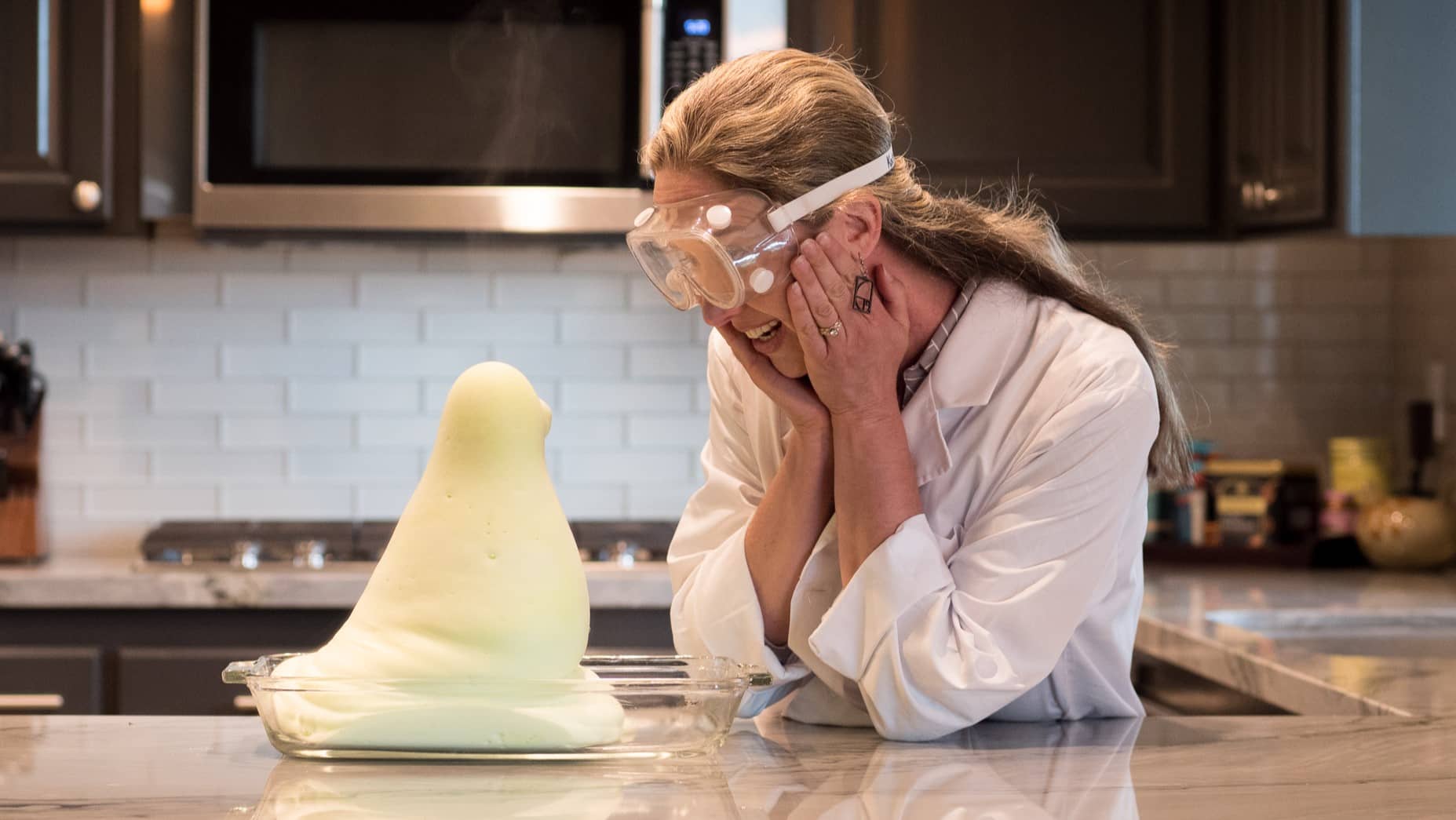
In all honesty, this isn’t a particularly useful reaction, but it’s fun and rather impressive. This is the sort of chemistry that makes even the most stoic of teenagers look twice. Gather the following materials:
- Tall, slender bottle, around 16 oz.
- ¼ c. Dr. Bronner’s Sal Suds Biodegradable Cleaner
- ½ c. Hydrogen peroxide (pharmacy grade 3% will work, though if you can get your hands on 6% or higher, that’s even more fun.)
- Squirt of food coloring
- 1 Tbsp. Yeast
- Very warm water – enough to dissolve the yeast
Combine the Sal suds, hydrogen peroxide, and food coloring in the bottle. Place the bottle in a 13”x9” pan for catching the overflow. Dissolve the yeast in the warm water. Pour the yeast water into the bottle (a funnel might help). Stand back and enjoy the reaction!
If you’d like a full scientific explanation of what’s happening in this reaction, check out my third Experiments in Soap video!
Bar Soap Slime
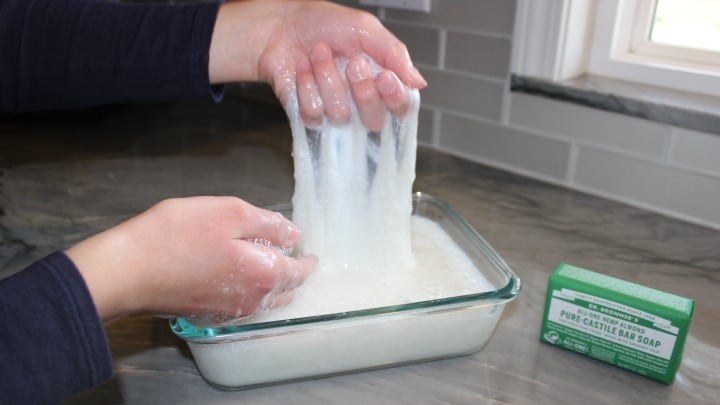
I discovered this fun stuff totally by accident. I was trying to figure out how to liquify bar soap, because a lot of readers had asked me if it was possible. After a bit of trial and error, I was successful. I had left the stuff on my kitchen counter and came back to find my daughter happily squishing the goo through her fingers. “Mom! You made slime!” She was thrilled because I had never been a fan of the borax-and-glue homemade slime, but this was one I certainly endorsed.
Slow method:
Cut half a bar of Dr. Bronner’s Pure-Castile Magic Bar Soap into 1/2” cubes. Soak this in 2 c. water overnight. Blend this on low in your blender.
Fast method:
Grate half a bar of Dr. Bronner’s Pure-Castile Magic Bar Soap with a fine grater. Combine with 2 c. warm (not hot) water in a blender. Blend on low.
Pour the blended soap into a bowl. Sometimes it’s really foamy right after blending, but if you let it sit for a few minutes, it’ll get nice and slimy. The foam is fun to play with, too
After playtime is done, be sure to rinse hands well. This is, after all, soap, which shouldn’t be left on skin. Also, it is the purpose of soap to grab hold of oils, so playing with this for extensive periods of time can be drying. Consider limiting slime time to 10 minutes per session and follow up with some Organic Magic Balm . This concoction can then be used for bath time or handwashing or any other cleaning needs.
The point to take away: chemistry happens
The takeaway I hope you have here is that chemistry happens everywhere. In many circumstances, chemistry in action is wonderful. Chemistry turns flour, water, and yeast into delicious bread. Chemistry makes soap so awesome at cleaning. But chemistry can get us in trouble, too. However much we might wish for two substances to work side by side with each other, sometimes they just can’t get along peaceably. Do your research before you get to mixing it up. I am happy to answer any questions you have.

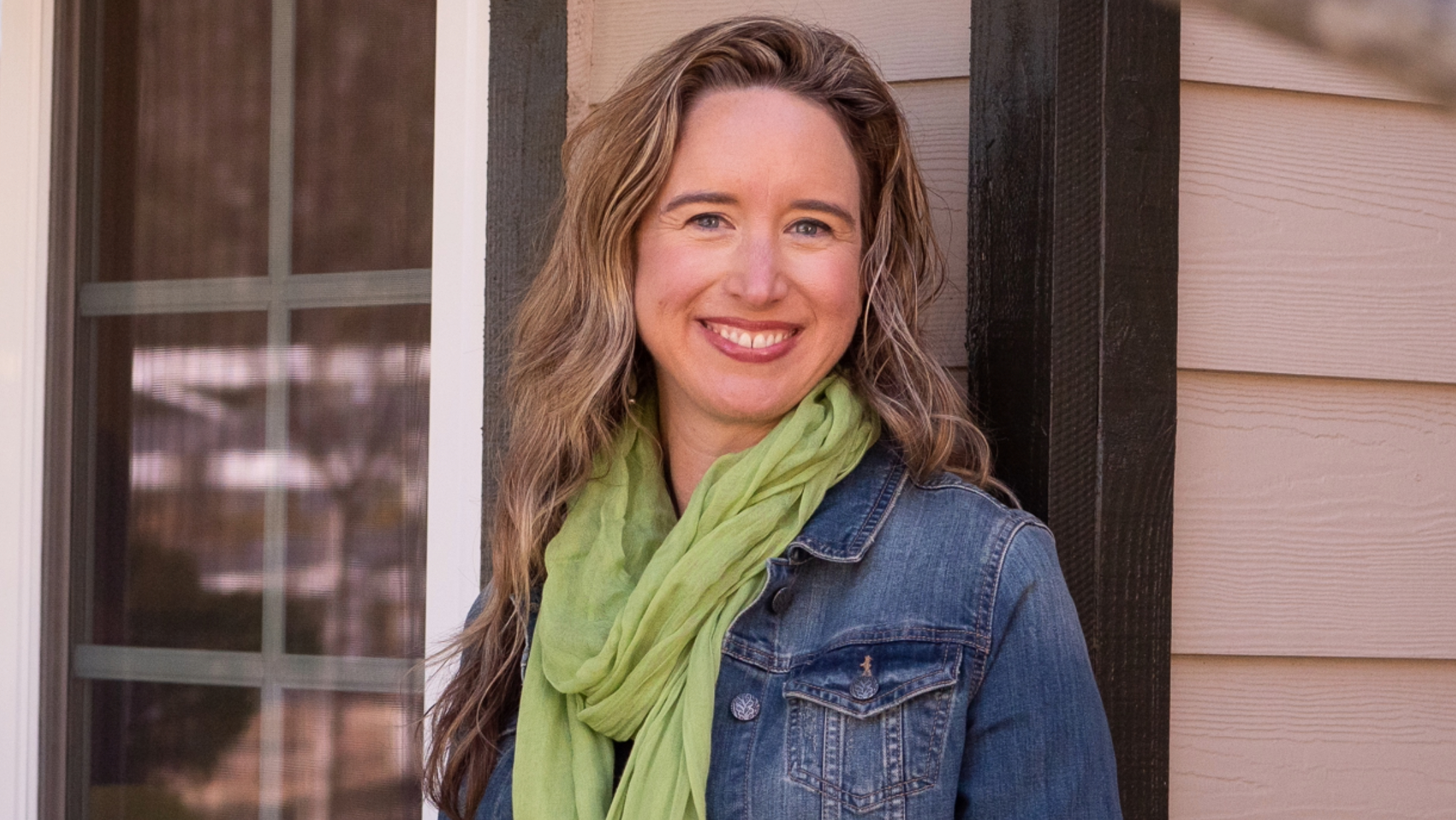
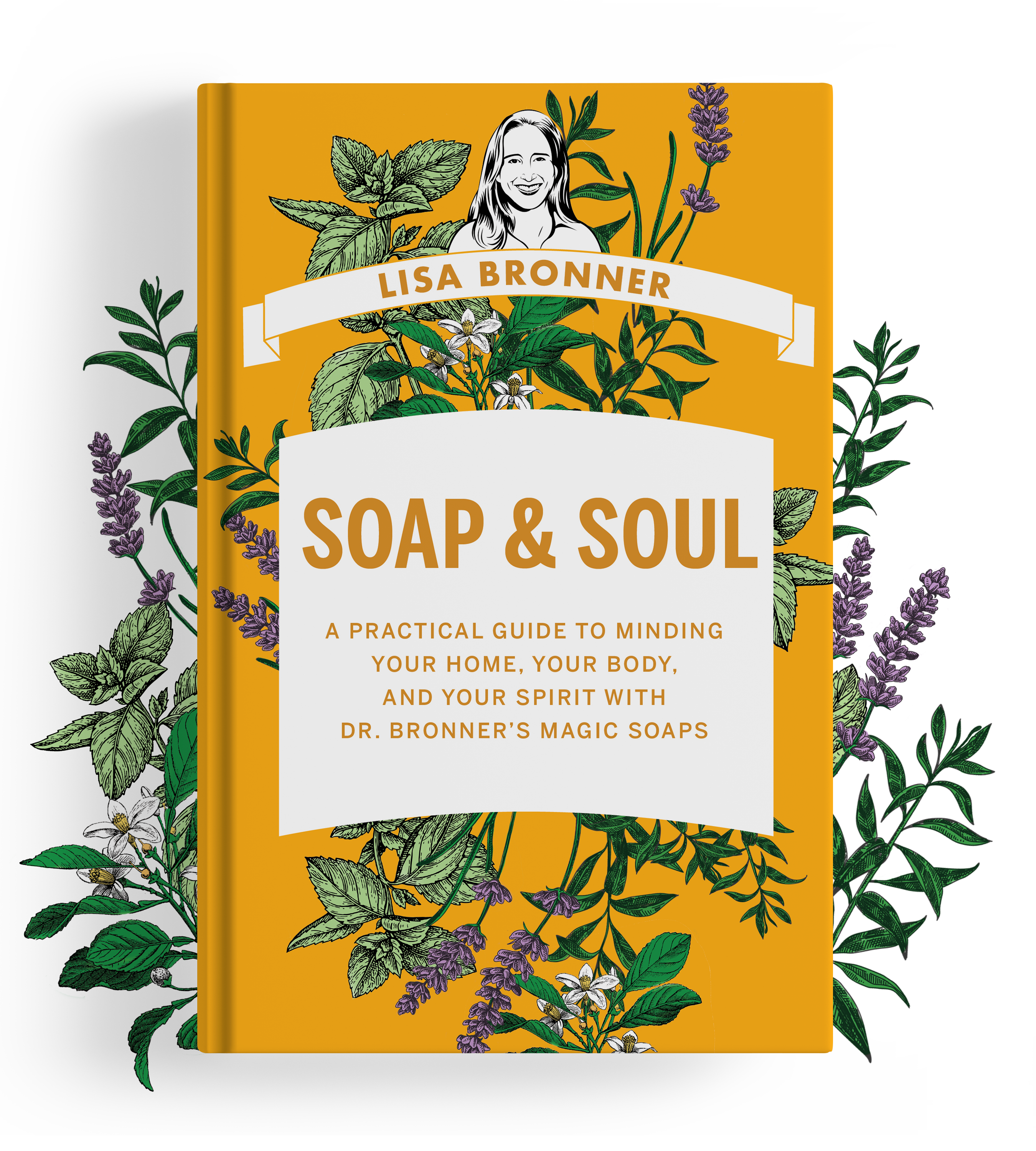
This is wonderful. It reminds me of my high school chemistry class and my teacher, Roy Fritch, now retired and serving on a Museum board in my home town of La Junta, Colorado. https://www.oteromuseum.org/museum-board.html. A group of students in his Chemistry and Physics classes put together a Science Magic Show to display to other students chemical reactions to draw interest and attention to Chemistry and Physics. I remember this FUN part of Science very, very much. Keep up the good work!
Thank you Lisa !
Very educational for me. Who the heck concocted the elephant toothpaste ? Wild.
Hi Tim! Great to see you here! Undoubtedly it was someone with unquenchable curiosity who asked, “I wonder what would happen if…” You well know that my dad was very much like that. I don’t know if he ever made this particular concoction, but he made many other fun foams!
A friend of mine uses vinegar and baking soda as a drain cleaner. Stuff 1/3 of a cup of baking soda into the drain, add 1/3 cup of white vinegar. When it stops foaming follow with a whole lot of boiling water. She adds“may still need to plunge.“ I find it works pretty well on my drains without use of a plunger but I was wondering if you had something equally or more effective. It would probably benefit from more boiling water, but I only use 1.7 L which is the capacity of my kettle. It isn’t the kitchen sink that gets clogged. It’s the back bedroom!
Hi Ellen – There are times that the reaction itself with the release of gas can be helpful to jostle grime off a surface, such as inside your drains–in this case it can help to deodorize a stinky drain and speed up a slow drain. (It’s not going to clear a blocked drain, though.) Sometimes all you need is the hot water, or a flush of vinegar, followed by hot water (not boiling). The vinegar would also help if you have scale build up from minerals in water. Thinking about that back drain you mentioned, the next step is to check for a physical blockage by using a drain snake or by opening up the P-trap underneath the sink (put a big bucket under it before you do this) and see if there is a build-up of materials in it. I know that’s a super big and stinky pain, but it always helps in my house.
My grandkids are too old for the experiments, but I’m not! I’m looking forward to the fun.
Many years ago I tried cleaning a real nasty shower with bleach and then ammonia. I have never mixes cleaners again, to say the least.
But I am going to try these.
Thank you so much for the informative article.
Thank you for the kind words, Paddy. I’d love to hear what you think if you try it!
I’m so glad I read your email! I’ve been mixing baking soda, vinegar and suds! Sometimes hydrogen peroxide as well or separately with suds. I will print your chart. Just want to get clothes clean and fresh without toxic chemicals and smells! I’ll keep reading to see what I can mix together safely. Thanks again Lisa!
Thanks for the kind words, Dawn. I’m so glad that this article was helpful to you and please let me know if you have any questions!
Lisa, I love you. Your pictures are absolutely ADORABLE! I am going to make this slime with my grandkids! I also LOVE Chemistry. I wish that they had made it loveable when I was in school in the 70’s and 80’s. One of my kids went to NAU and majored in Chemistry, ended up with a degree in Biology. Her favorite subject was Chemistry though. Anyway, I LOVE this blog post and thank you for sharing it!! Have a very Blessed day!
Thanks for the kind words, Lucia!